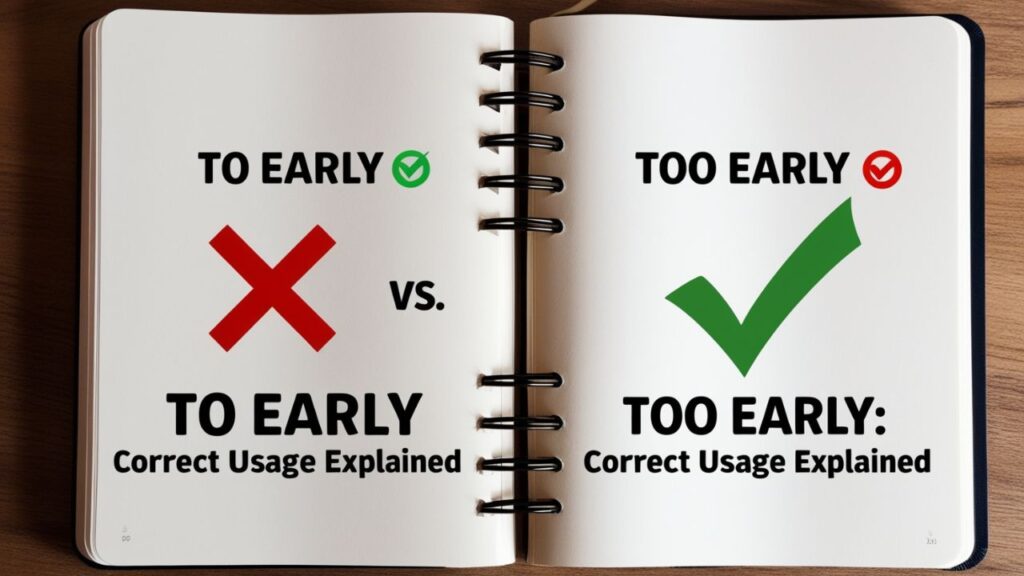Homophones like to and too sound the same but have different roles. To usually shows direction or links actions, like “I walk to school.” Too expresses extra amount or inclusion, such as “The room is too bright for reading.”
Using the correct word makes sentences clear and professional. Too highlights intensity or feelings, while to connects actions or verbs. Writers often mix them up, but careful attention keeps messages correct and easy to understand.
Daily examples help learning. Say “It’s too early to eat” for timing, and “I’m going to the store” for direction. These small changes make writing accurate and show understanding of basic English rules.
Deciphering “To” vs. “Too” – The Core Confusion
The word too adds extra meaning to feelings or actions. It shows when something is more than usual, like “The soup is too hot.” It also includes people or things, for example, “She wants to come too.”
Using this word correctly makes sentences stronger and clearer. Too helps explain intensity, amount, or inclusion. Writers can show feelings better with phrases like “He runs too fast” or “I have too many books,” which makes communication precise and understandable.
English homophones often cause confusion. To and too sound identical but perform very different jobs.
- To serves as a preposition (“I walk to school”) or an infinitive marker (“to sleep”).
- Too acts as an adverb, meaning excessively (“too hot”) or also (“me too”).
Understanding Intensifiers: The Role of “Too”

In daily life, too early shows that the timing is not right. For example, “It is too early to eat breakfast” or “The sun is too bright to play outside.” These phrases make meaning clear and simple.
In school or work, this phrase helps explain actions. “The meeting is too early for students” or “The project started too soon” shows that events happened before the right time. Using such examples improves understanding and keeps sentences accurate.
When you say “too early,” too amplifies early – expressing excess or undesirability.
- Excessive tone: “Your coffee’s too sweet.”
- Inclusive tone: “I’m coming too.”
Too contrasts with other intensifiers like very or quite, but uses emotional emphasis. Common expressions:
- “Too late”
- “Too many options”
- “Too good to be true”
Examples in Context: When to Use “Too Early”
Using too early helps show that something happens before the right time. For instance, “It is too early to start homework” or “The meeting began too soon.” These examples make sentences clear and easy to understand.
Writing clarity comes from real examples that resonate. Here’s a practical breakdown:
Read More : Heyday or Hayday: Correct Usage Explained Clearly
Everyday:
In everyday situations, too early helps explain timing clearly. For example, “It is too early to eat lunch” or “She woke up too soon.” These phrases show when actions happen before the right moment, making sentences easy to understand.
Workplace:
In work settings, too early explains when actions happen before the right time. For example, “The meeting started too soon” or “It is too early to send the report.” Using it helps make instructions and schedules clear.
Academic:
In school or college, too early shows when tasks or events happen before the correct time. For example, “The assignment was submitted too soon” or “The class started too early.” Using it helps keep learning and schedules clear.
Mistakes to Avoid: Remembering the Difference

Common errors happen when writers confuse to and too. For example, “to early” is incorrect, while “It is too early” is right. Paying attention to this small difference makes writing clear, professional, and easy to read.
Check your writing against these common pitfalls:
| Mistake | Why It’s Wrong | Correct Usage |
|---|---|---|
| To early | To isn’t an intensifier | Use Too early |
| Too bed? | Mixing up infinitive form | Use To bed (go to bed) |
| Me to at party | Wrong part of speech mix-up | Use Me too |
Memory tip: Too has an extra o – just like it adds emphasis. Whenever you aim for emphasis or inclusion, think too.
The Nuances of English Prepositions: Using “To” Correctly
The word to shows direction, connection, or purpose. For example, “I go to school” or “She wants to read a book.” Using it correctly links actions and objects, making sentences clear and easy to understand.
As a preposition, to connects a verb or action to a target.
- Deliver this to her desk.
- Ready to present?
See More : Plurals of Ox and Fox Explained: Oxen vs Foxes in English
As an infinitive marker, it pairs with base verbs:
- I plan to travel.
- She hopes to finish soon.
Note: Confusing these leads to phrases like to early, which misplaces a preposition or loses its adverbial function.
Quick Grammar Rule: How to Decide Between “To” and “Too”
To choose correctly, check the role of the word. Use too to show extra meaning or inclusion, like “It is too early.” Use to for direction or with verbs, such as “I want to read.”
Try this four-step check:
- Identify the role (action/connection vs. emphasis/inclusion).
- Substitute also or excessively:
- If it works, use too.
- Otherwise, to is safe.
- Look for prepositions or infinitives.
- Use the too double o trick.
This builds accuracy without second-guessing your work.
Expert Insights: Grammar Authorities Weigh In
Grammar experts highlight the difference between to and too. Style guides like Chicago Manual of Style and Oxford English Grammar stress that too shows intensity, while to links actions or directions. Following their advice improves clarity and professionalism.
Language authorities consistently underline this distinction:
- Chicago Manual of Style emphasizes too as intensity, to for direction/infinitive.
- Grammar Girl (Mignon Fogarty) uses humor to reinforce the too vs. to difference.
- Oxford English Grammar demonstrates error frequency in learner corpora.
Their collective advice: reinforce clarity and avoid homophone errors.
Case Study: A Real-World Email Misstep
Jamie wrote, “It’s to early to send the report,” in a client email. The mistake reduced credibility. Correcting it to “It’s too early to send the report” added clarity and professionalism, showing the importance of careful word choice in communication.
Scenario: Jamie wrote to a client: “It’s to early to finalize the report.”
Result: Client noticed the typo before reading details. Jamie’s credibility took a hit.
Correction: Rewriting: “It’s too early to finalize the report” – Adds emphasis and avoids confusion.
Lesson: Homophones matter in business. One mistyped o can change meaning and tone.
Final Thughts
The word to shows direction or connects actions. For example, “I go to school” or “She wants to study.” Using it correctly keeps sentences clear and makes writing more professional in daily life and work.
The word too emphasizes extra meaning or includes someone or something. For instance, “It is too early to start” or “I want to join too.” Correct usage improves understanding and makes sentences stronger and easier to read.
Remembering the difference between these two words helps avoid mistakes. Paying attention to context and meaning ensures writing is accurate. Using too and to properly adds clarity, confidence, and professionalism to communication.
FAQs
Can “to early” ever be correct?
No. The phrase “to early” is always incorrect. Use too early to show that something happens before the right time.
Why do people confuse “too” and “to”?
They sound the same, but have different roles. People often use to by habit, even when too is needed for emphasis or inclusion.
Is it okay to use “too” in formal writing?
Yes. Using too for emphasis or inclusion is correct in formal writing, including emails, reports, and academic papers.
What quick trick helps me get it right?
Substitute also or excessively in the sentence. If it makes sense, use too; otherwise, use to for direction or connection.
What tools can catch this error?
Grammar checking tools like Grammarly, Hemingway Editor, and Microsoft Editor can spot mistakes. Reading your writing aloud also helps catch errors.

Join Bibcia on a journey to master English grammar. Discover easy lessons, writing tips, and practical examples designed to make learning grammar simple and effective.










